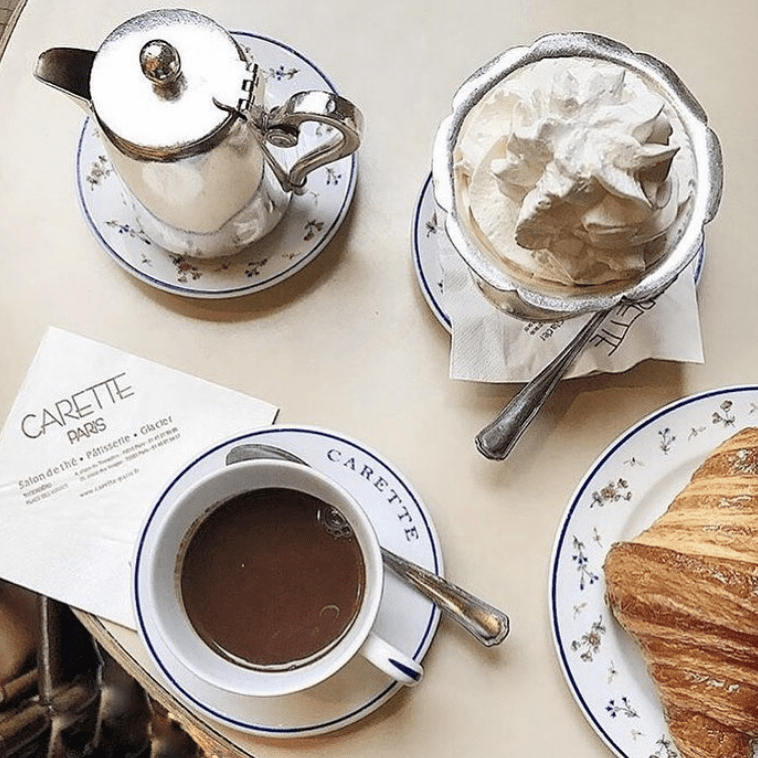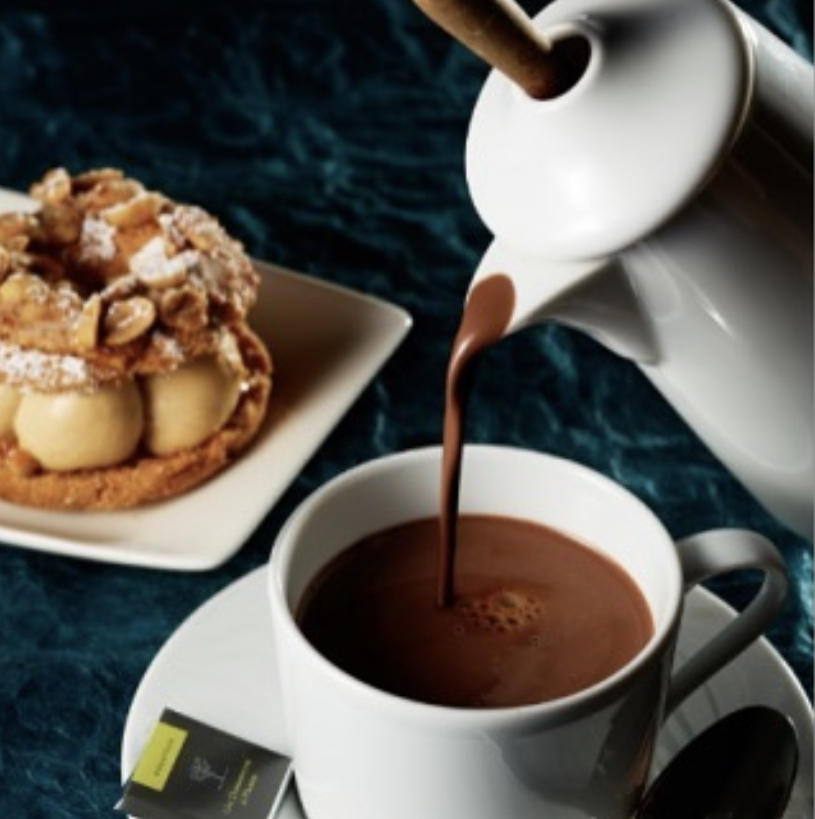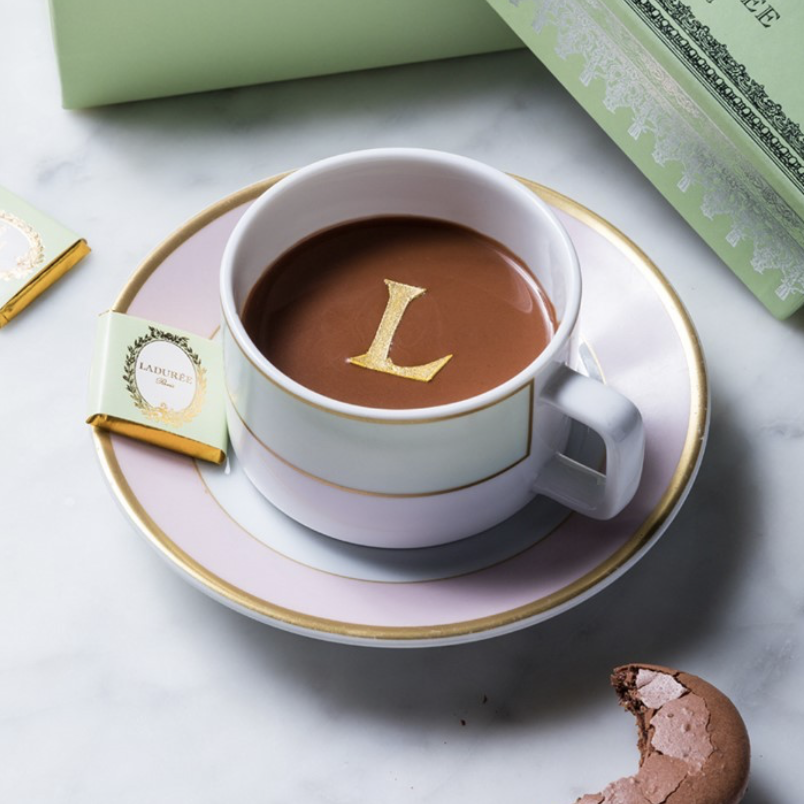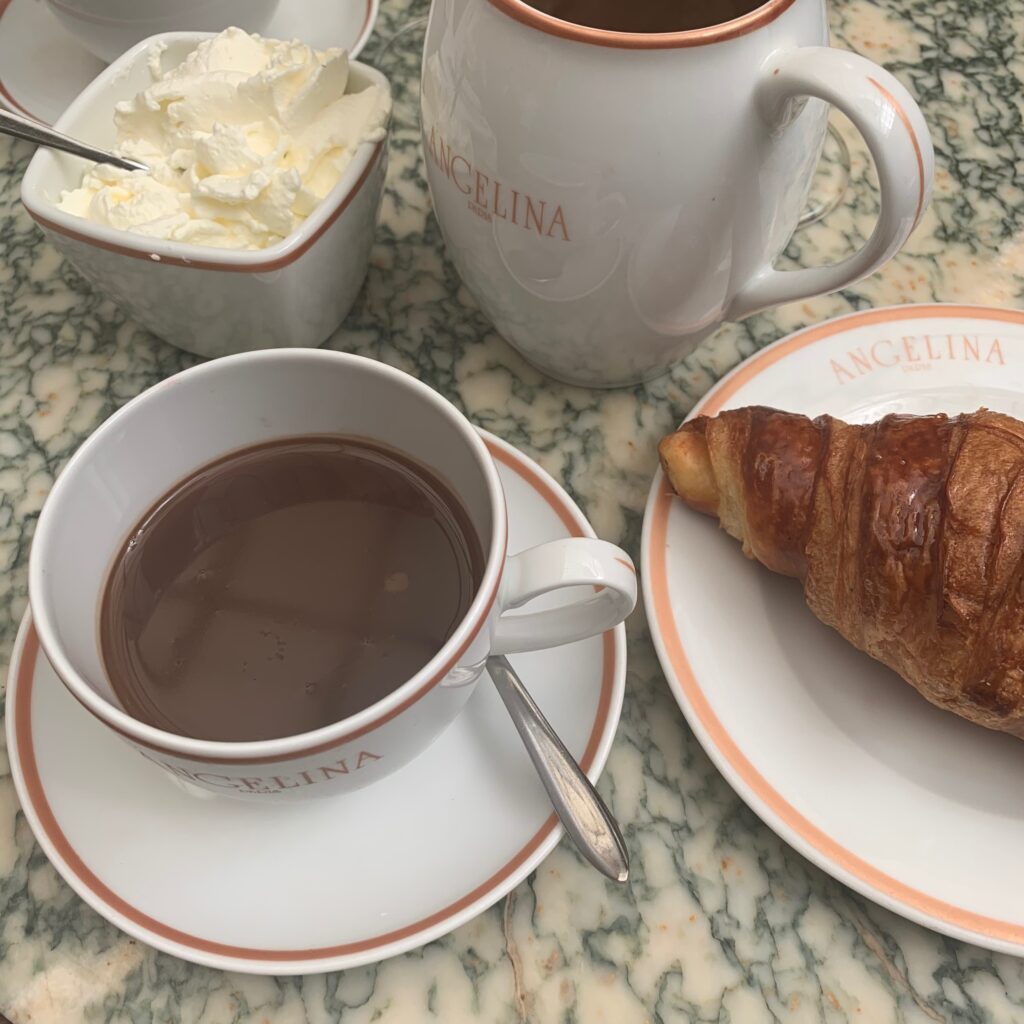You can order delicious chocolats chauds all over Paris. Blends of steaming creamy milk whisked through with melted chocolate for a luscious effect. Often served with a side of Chantilly cream because, well, pourquoi pas?
But you ideally want your ambience to be as sumptuous as the drink itself. Read on for five spots that serve up a hot chocolate in extra-special style …
Carette, Place des Vosges, 75003

While you sip the molten chocolate (soul-satisfyingly rich and sweet) out of a pretty floral porcelain cup, overlooking the lovely Place des Vosges, you might like to reflect on how you’re continuing a tradition that goes back centuries in the Marais.

As the district took off in the seventeenth century, chocolate drinks were becoming popular at court, thanks to a couple of Spanish queens who imported the craze from home (where cocoa had in turn been imported from Mexico). The fad then filtered to the salons of the Marais, where high society were building their luxurious new townhouses. One of that century’s most influential tastemakers, Madame de Sevigné, who was born on Place des Vosges, directly across from Carette, was a huge fan of chocolat chaud. It will ‘make the most unpleasant company seem good to you,’ she insisted.

Follow up your chocolate-charged breakfast with a day at the Musée Carnavalet, situated within a grand old hôtel particulier in which Madame de Sevigné herself once lived. As you walk around the beautiful boiserie-lined rooms — old salons and spaces saved from demolition and given a new home in this museum dedicated to the history of Paris — keep a look-out for the rooms of the former Café de Paris and Café Militaire, which would have served up their fair share of hot chocolate back in the day. More on the history of Parisian cafés below …
Un Dimanche à Paris, Cour du Commerce Saint-André, 75006

In this prettily paved passageway, you’ll find a chocolate-shop-meets-tea-salon that not only offers another superb chocolat chaud (one of the most pleasingly thick you’ll come across), but another history lesson, too.

Ask to sit by the curved stone wall …

This is actually the base of one of the towers of the city’s twelfth-century defensive wall — see top left of the 1615 Mérian map, pictured below.

For centuries this wall separated Paris proper from the suburbs, where Saint-Germain, named after its ancient church and former abbey, abounded in fields (prés). The area, however, steadily became a popular stomping ground, especially as it was home to the Saint-Germain Fair (above image, top right; where the Marché Saint-Germain now is), where traders would come from all corners of the expanding world to sell their exotic wares.

The imported delights included the drinks of tea, coffee and chocolate, usually sold by itinerant merchants who lugged around tanks, flasks, jugs and cups (see illustration above). Many of these merchants went on to set up the city’s first coffee houses. One of the earliest, Le Procope, still stands today, just across from Un Dimanche à Paris. (Le Procope is a restaurant these days, but it’s worth having a meal here, to savour the historic chandelier-lit, gilt-trimmed atmosphere as much as the classic Gallic food.)

It was here where philosophers such as Voltaire gathered, in the eighteenth century, to talk liberté and égalité, fuelled by a stimulating blend of coffee or hot chocolate. (Voltaire, incidentally, high achiever as he was, liked to mix the two.)
Les Deux Magots, Place Saint-Germain-des-Prés, 75006

Since Voltaire’s day, Saint-Germain has been known as the spiritual centre for philosophical and literary types, who have flocked to the area’s proliferating cafés. One of their favourites, since the late nineteenth century, is Les Deux Magots. So it’s ideal if you like to brush up your French while eavesdropping on high-minded conversations. But it’s also great for people-watching, being situated on the central Place Saint-Germain.

Request a table en terrasse, order a pot of hot chocolate à l’ancienne, and slowly sip the silky-smooth concoction as you watch the world go by. There’s also a Viennese Hot Chocolate on the menu, which is thicker thanks to the addition of egg yolk, but if you have extra room in your stomach a better option would be to fill it with something from the pastry tray, with its mouth-watering selection of Pierre Hermé treats. (An ispahan, perhaps? Oui please!)
Ladurée, 21 Rue Bonaparte, 75006

If you prefer your cafés as cosy as your hot chocolate, head north along Rue Bonaparte, and flit up to the first floor of Ladurée.

The hot chocolate here is lush and velvety, as is this gorgeous blue-themed tea salon — an homage to the famed interior designer Madeleine Castaing, who lived and worked in this corner space in the second half of last century.
Angelina, 225 Rue de Rivoli, 75001
Last but not least, of course, is Angelina, lauded worldwide for its chocolat chaud dit l’Africain, so named because of its base of African cocoa beans.

The drink is dense and aromatic and makes you want to melt for the sheer pleasure of it. Part of its myth, of course, could be that its long list of fans includes Coco Chanel and Marcel Proust. And the golden glow of the Belle Époque tea salon surely enhances the multi-sensory appeal.

Another way to enjoy Angelina’s hot chocolate is to-go, sipping from a sweet blush-pink takeaway cup as you stroll about the Jardin des Tuileries opposite. Or around the delight of a park that is the Jardin du Luxembourg, for there’s also an Angelina tea room at the north-western entrance, just by the Musée du Luxembourg.

Make sure to stop and salute the statue of Anne of Austria as you wander about; the Spanish princess was the first to introduce Paris to drinking chocolate, when she married King Louis XIII in 1615.
Like all the best things in life, Parisian-style hot chocolate never gets old.

